9-step landing page advertising strategy to maximize conversions

Your landing page is a finely-tuned engine designed to convert. But engines need fuel to work. In the case of landing pages, this fuel is a continual stream of visitors.
There are many ways to attract people to a landing page, including SEO and content marketing. But landing page advertising is the fastest way to push targeted traffic to your offer.
It’s easy to start promoting your page with paid ads, but it’s not always easy to run profitable campaigns. Improve your chances of generating a positive return by following these 9 steps.
Landing pages that convert
Convert visitors with landing pages built using MailerLite. Start quickly with a customizable template or design a page from scratch with our drag-and-drop builder. Hit the button to find out more.
1. Choose an ad platform
Most new advertisers begin with one of the two main channels: Meta Ads Manager, which lets you run ads on Facebook, Messenger and Instagram, and Google Ads, which includes Google Search, Display, and YouTube Ads.
These are the most popular platforms for 3 main reasons.
They have a large user base and granular targeting options. You’ll have no problem reaching your target customer base.
They are easy to use. Anyone can create a campaign on these platforms. They also have tools that automate much of the process.
They are very affordable. You can start with a budget of just $5 daily on Meta platforms. Google recommends that beginners spend between $10 and $50 daily.
Despite these similarities, there are significant differences in how each service works. Here’s a rundown of each platform to get you up to speed.
Google Search
Google Search ads are shown when someone searches for your chosen keywords. The pay-per-click (PPC) model means you only pay when someone clicks on your ad.
To get started, identify the terms your target customer is searching for. You can use Google’s Keyword planner to find queries and get price estimates.
Imagine your landing page is for a yoga course; advertising on keywords like “Yoga course,” “Best yoga course” or “Online yoga course” means your page will show up on these terms.
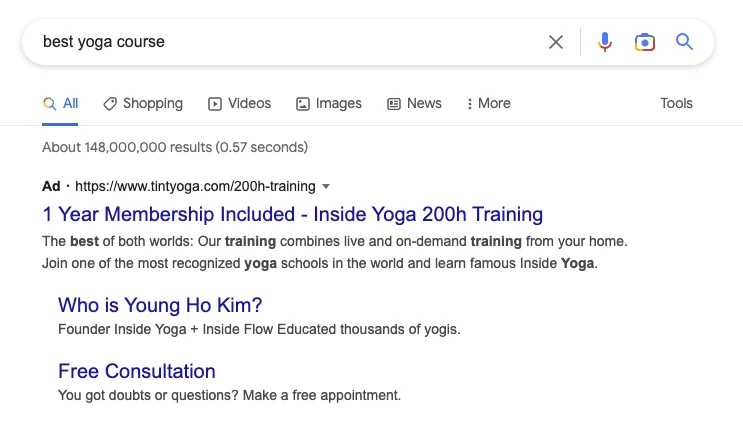
The problem with Search ads is that competition can be intense. The highest-converting keywords typically have a high cost per click.
Minimize your cost per conversion by optimizing your offer and post-click email funnel to make the most of every click.
Google makes advertising on its platforms easy. Take the Skillshop Google Ads course to learn more.
People use different terms when searching for the same product. For example, they may use both “Google ads course” and “Course to learn Google ads” to find ways to learn about advertising on Google.
Google uses keyword match types to let advertisers promote their pages on multiple similar keywords without having to specify each term. You can choose broad match, phrase match, or exact match depending on how close you want the meaning to be to your main term.
Beginners or those with low budgets should use exact match or phrase match keyword types to show ads on searches that closely match the meaning of your main keyword. You’ll avoid spending your budget on loosely-related keywords that are harder to convert.
Google Display Network
Google Display Network (GDN) allows you to display ads on over 2 million websites. The tool has targeting features so you can show ads to people based on their estimated interests, intents, or demographic.
Retargeting is one of the most powerful features of Google Display Network. It allows you to display ads to people who have already interacted with your website or brand.
This works because these people have a proven interest in what you sell. They also typically convert at a higher rate.
You can also use remarketing to highlight additional elements of your product or service that weren’t obvious in the original ads, thus painting a detailed picture of your overall offering.
Creating great-looking display ads is easy, thanks to Google’s tools. Responsive Display Ads allows you to define ad creative like headlines, call-to-action, and images, and Google will automatically use these elements to show ads in various sizes and dimensions.
Meta Ads Manager
Meta Ads Manager allows you to serve ads on Facebook, Instagram and Messenger. You can run ads in the feed or in stories. Just upload visuals and text, and the platform will optimize your ads based on your chosen goal.
Meta Ads’ targeting options help you reach people based on their demographics, interests, behaviors, or location. This is useful if you have a specific customer in mind. Like Google Ads, Meta’s platform offers powerful retargeting features.
You can also create a Facebook custom audience using your existing customer data, such as your MailerLite email subscriber list. This will find people on Facebook who match the characteristics of your subscribers and will likely see value in your product.
Get started by going through the Meta Blueprint courses to learn about targeting and creating compelling ads across the Facebook family.
Microsoft Advertising: Run ads on the Microsoft Bing search engine
Linkedin: Reach a global network of professionals
Twitter: Target Twitter users with awareness, consideration, or conversion campaigns
Quora: Show ads to people based on topics, interests, keywords, or questions
TikTok: Run ads on the fastest-growing social media platform
Reddit: Target people based on interests or subreddits
2. Create messaging that resonates
The second part of advertising your landing page is researching your target audience to better understand their needs, wants and challenges. This will allow you to create ads and landing pages that resonate and are more likely to lead to conversions.
Here are 4 ways to find out more about your customers.
Customer reviews
Look at customer reviews to see how people use your product and what they like about it.
The below screenshot from the review platform, Capterra, shows what customers love about MailerLite. With this insight, we can guess that focusing our promotions on our landing page feature, customer service, and generous free trial will result in effective ads.
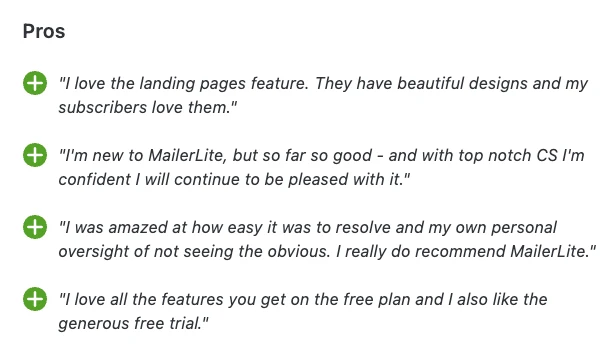
Customer surveys
Run customer surveys to find out why people use your product and what they like about it. Use this insight to create ads highlighting how your product helps people overcome their problems or meet their goals.
MailerLite customers can easily design an email survey using our survey blocks and then send it to customers via email.
Use sales data
Sales teams speak to potential customers daily and get instant feedback when leads accept or reject their pitches. The best reps deeply understand what customers are looking for, which is essential insight for creating landing page ads.
If you have a sales team, speak to them to find out what leads react to. If you run sales yourself, think about the topics and offers that generate positive responses.
Analyze your competitors
Companies that can’t rely on their own resources can look to the competition to get the information they need.
Hunt down competitor reviews on third-party services to see what people are saying about the tool. Or look at landing pages to see how they position their service.
You can also use tools like Semrush to see examples of your competitors’ paid advertising to discover exactly how they promote their products.
Below are the ads for data science course provider DataCamp as shown in the Semrush Ads Copies tool. This is useful insight for any brand offering a similar course.
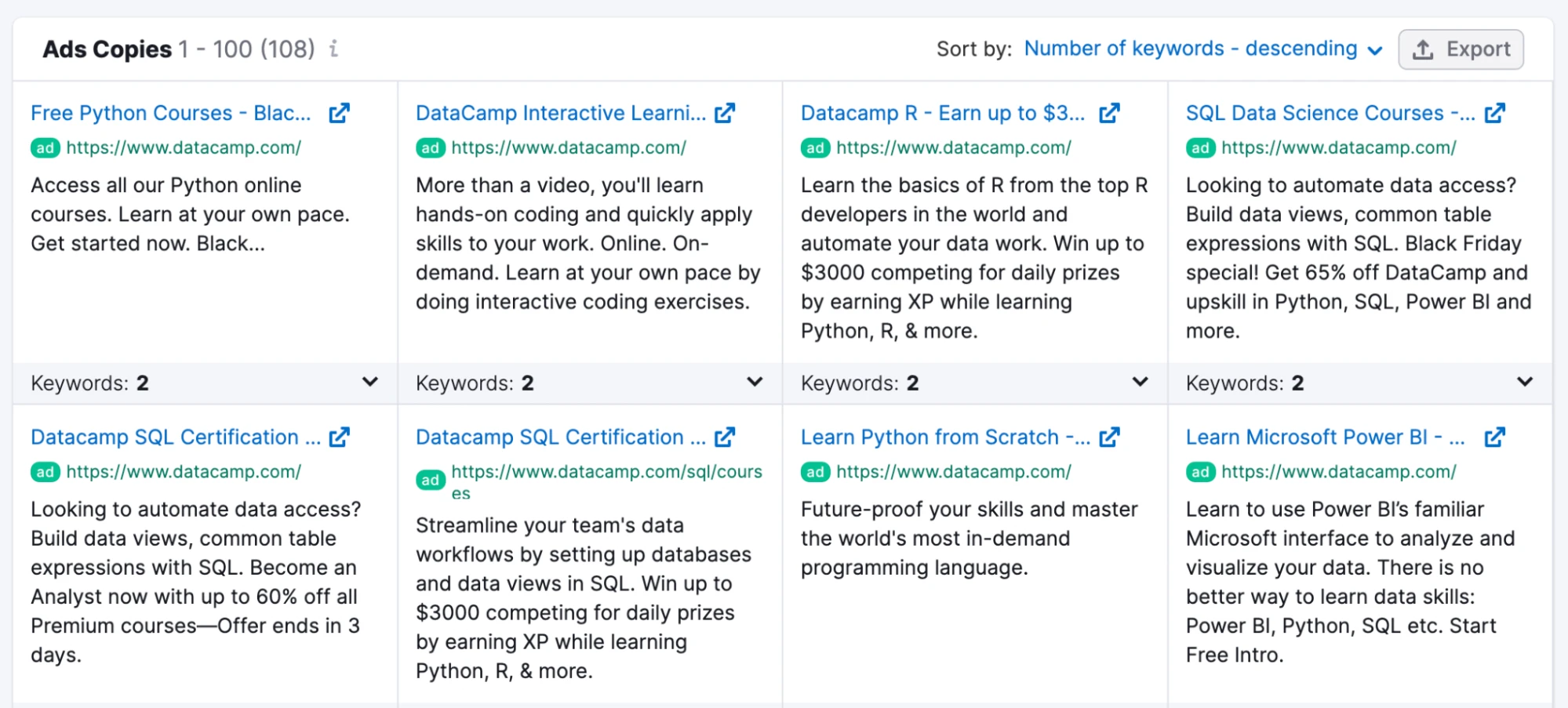
3. Create an offer
Your offer is an essential part of landing page advertising. People won’t convert if they aren’t interested in the offer, even if your ads and landing pages are perfect in all other areas.
Selling an expensive product to people with no previous knowledge of your company can be difficult. Many brands get around this by using their landing page ads to promote a freebie or a cheaper product and then using email marketing to build the relationship and upsell the lead.
Where possible, choose an offer you already use and know works, so you don’t spend your advertising budget experimenting. Just make minor tweaks to optimize the offer as you learn more about how it performs.
Here are some examples of the types of offers you can use.
Free trial
Allow people to access your product for free. This could be via a limited free plan or a free trial of your premium features.
This is a strategy we use in our ads at MailerLite. Once someone signs up for a free trial, we provide a ton of value so they convert into a paid customer.
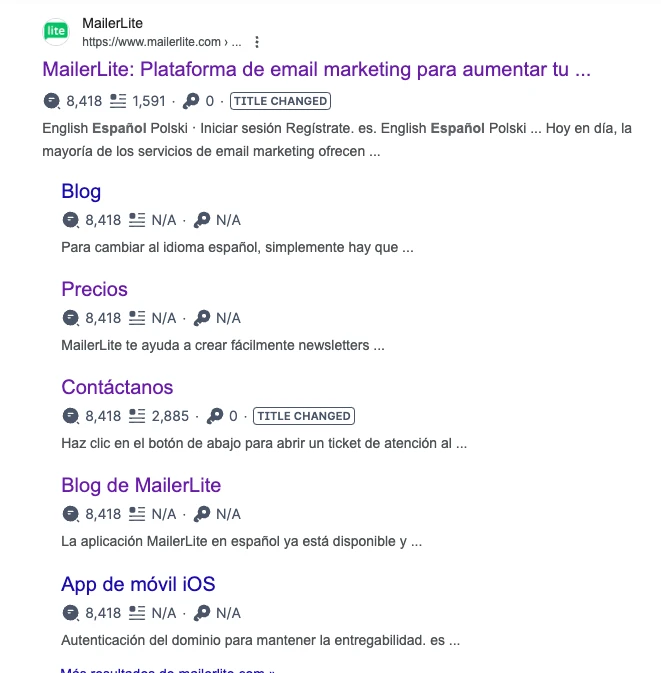
Gated content
Create a valuable resource that people can access if they hand over their email addresses. The resource should relate to the problem your product solves so it attracts people who may convert into paid customers.
This gated content could be ebooks, checklists, guides, webinars or anything else you think could help your target customer.
Intro products
Sell a taster version of your main product at a low price and then try to upsell your main product. This works because it’s hard to sell a high-ticket product using just landing page ads.
Marketing course provider ClickMinded does this by promoting a $37 course module which is just one part of its $1,997 training program.
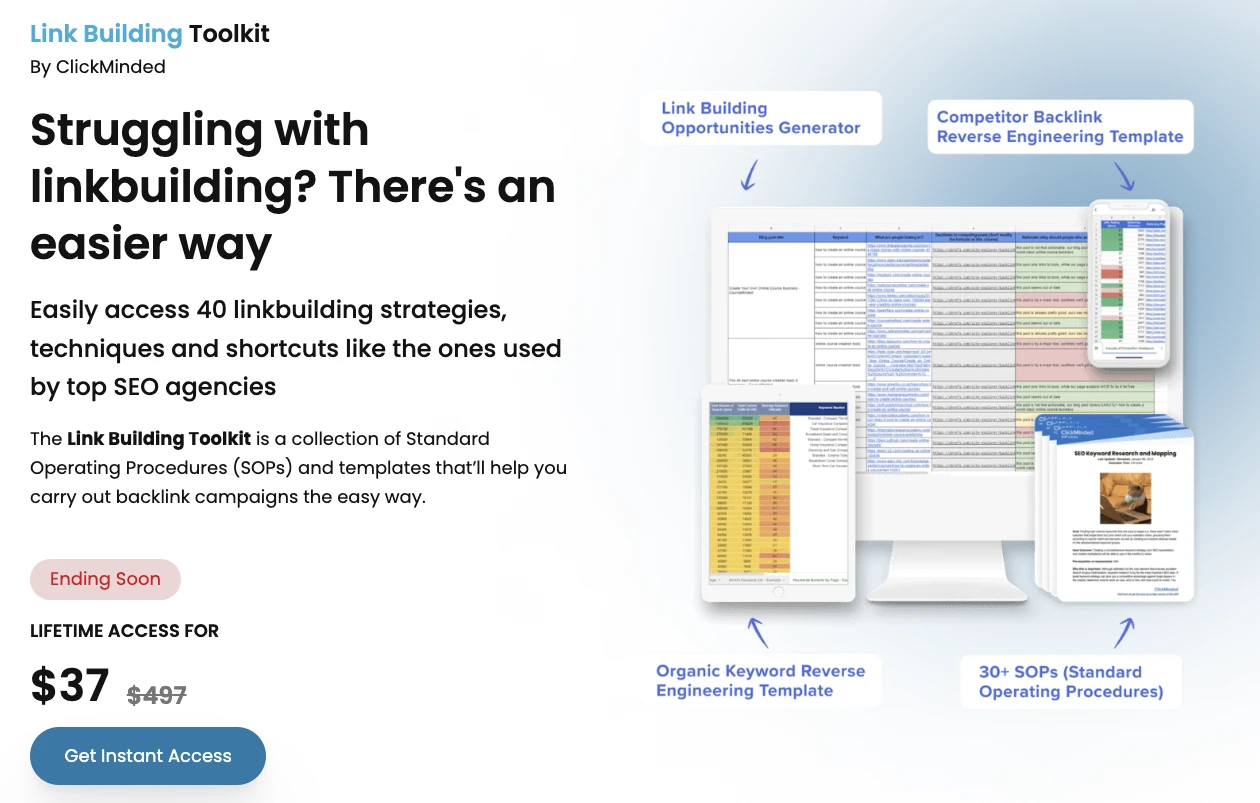
Book a call or demo
Sometimes it’s best to keep things simple. Ask visitors to book a call or a demo with your sales team to skip the lead nurture process and go straight to the end of your sales funnel.
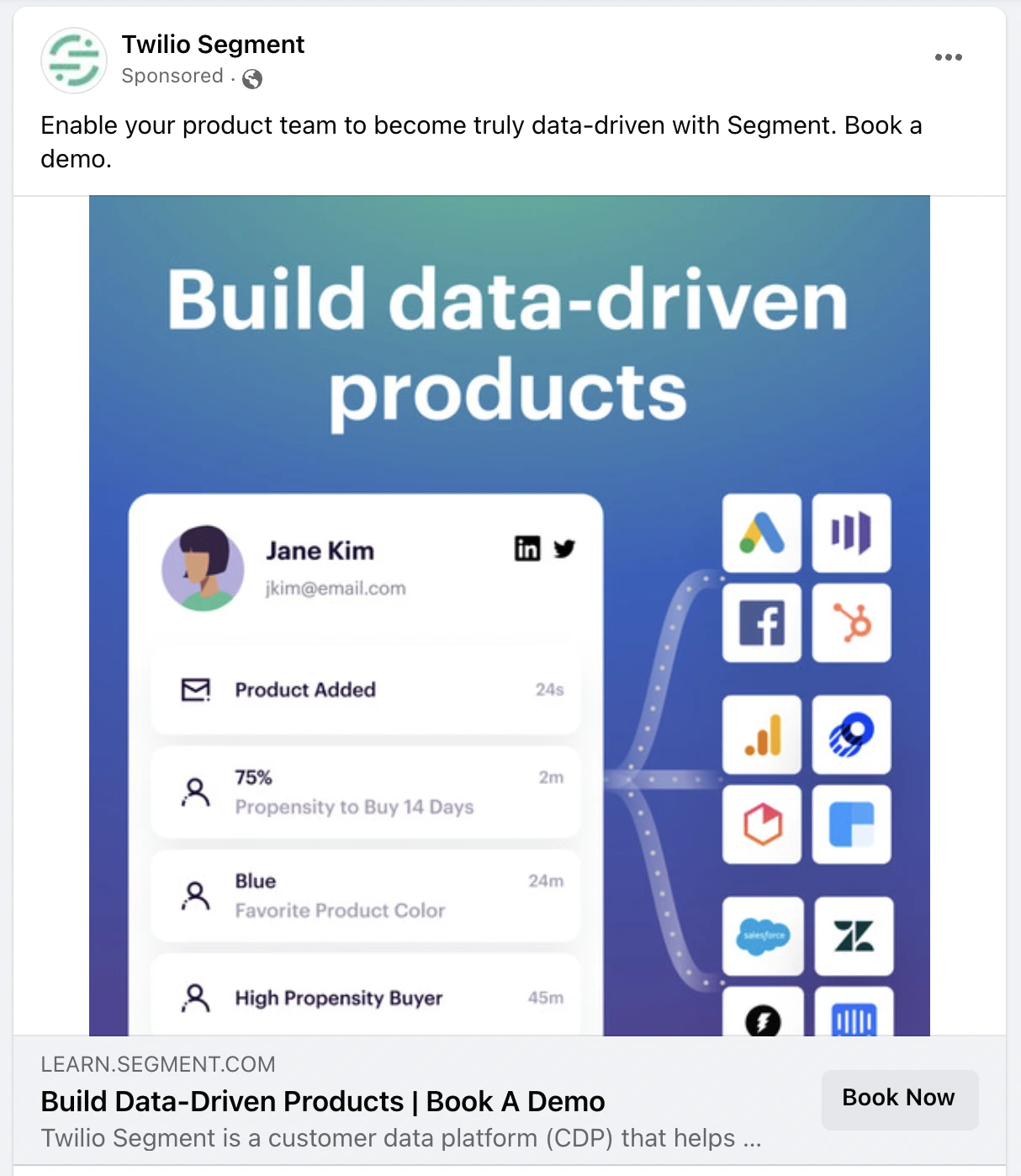
If your product is new, creating an offer is another area where you’ll benefit from competitor research. Look at the offers used by other companies in your industry to see what works.
4. Build your ad creative
Next, create the images and text you'll use in your ads. Each of the main advertising platforms has tools that will help you create ads that are effective on their respective platforms.
Here is a look at the type of ad creative that works best for each channel.
Search ads
Search ads are text only and promote your offer in short, sharp prose. Include your main benefit in the headline and support this with more information. Also, make sure your offer is super clear.
The ads in the screenshot below for the term “How to learn Spanish” tick all the above boxes.
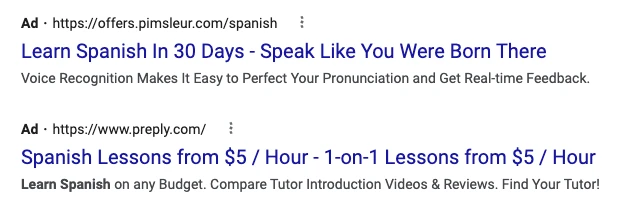
Display ads
Display ads use a combination of headlines, body text, CTAs and images. You don’t have much space to promote your product, so make your offer and benefits clear in the headline and subheading.
The display ad below from Semrush is a good example. It includes clear benefits in the main text and a clear offer in the CTA button.
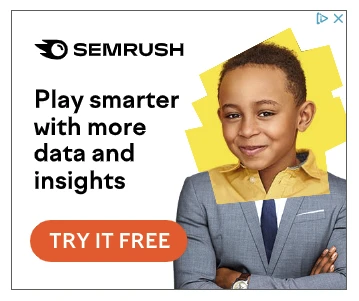
Facebook and Instagram ads
Facebook and Instagram ads need visuals and copy to hook the website visitor. They also have a dedicated space for a call to action.
You can include a lot of text in the body of the ad to provide more information about the offer. The below ad for a filmmaking course has almost an entire landing page worth of content, including benefits, testimonials and offers.
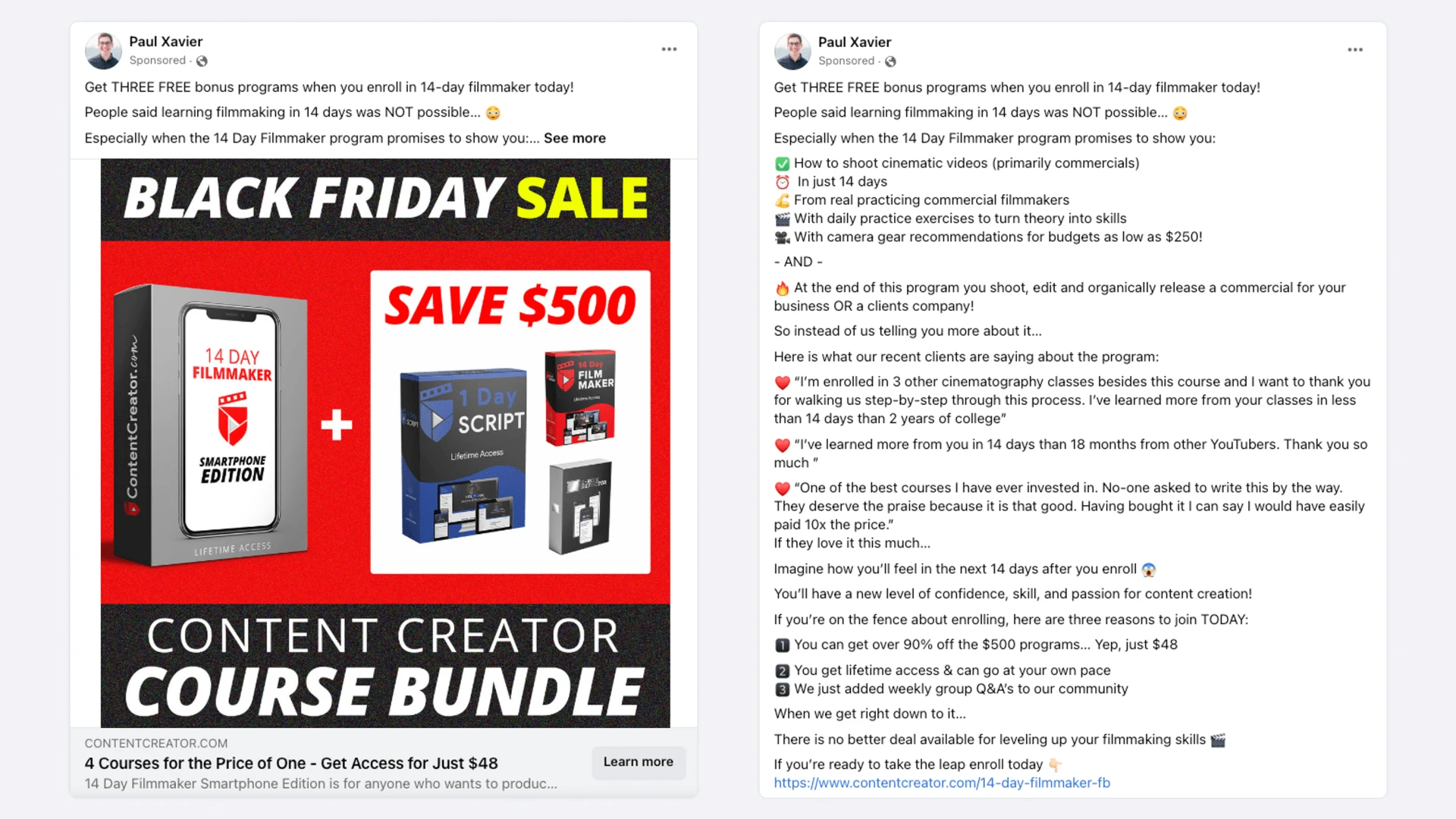
Experiment with your ad content. Try using testimonials, emojis or fun stats to deliver your message. Test long copy versus short copy or different types of multimedia.
5. Create a consistent funnel
Your landing page must deliver on the promise made by the ad and make it easy for the lead to take up the offer they have been promised. Also, use website design best practices like similar colors, logos, branding, and fonts, so customers know they are in the right place as soon as they arrive on the page.
The below screenshots of PhotoVibrance's funnel show a good example of this.
Both the landing page and ad headline focus on “Mind-boggling moving images”
The text focuses on the simplicity of the product
They both feature the $39 lifetime access offer
They have the same navy, white, and yellow color palette

6. Optimize your landing page
Before going live, check that your page is optimized for conversions to make the most of every click you generate.
Following the tips we’ve covered so far in this article will help you create a landing page that converts. But there are plenty of other things you can include to optimize it further.
You can add:
Business details and branding: Many customer journeys only include a few clicks. Make people remember your brand with pictures and your logo. Also, make it crystal-clear what your business does.
Social proof: When possible, use social proof and verified testimonials to help build trust with new visitors and increase their chances of converting.
Optimized landing page copy: Your landing page copywriting can have a huge impact on its ability to generate sales. Read this article for tips on how to create landing page copy that converts.
Privacy policy: Respect your prospect by being transparent about how you will use their data and providing a contact email. This will also help when getting your ads approved on advertising platforms.
Custom domain: This is optional, though we highly recommend setting up a custom domain for your web page if you’re planning to drive traffic through online ads. This will look more professional and trustworthy.
Remove barriers to conversion: Make the conversion process as easy as possible. For example, minimize the information you collect to require the user to sign up. Read this article for more on signup form best practices.
MailerLite makes it easy to create landing pages to use in your paid ads campaigns. We have plenty of landing page templates that make it easy to start.
7. Set up your post-landing page funnel
Your landing page and ads are just the start of the conversion funnel. Before you go live, ensure you have a funnel set up to convert people who sign up via the landing page into paid customers.
For most brands, this means setting up an email marketing nurture campaign. This is an automated sequence that builds a relationship with the customer while nudging them toward a conversion.
Create and automate nurture emails with MailerLite. Build a workflow that goes out whenever someone signs up for your offer to gently push them toward a sale. Find out more in our article on building email nurture campaigns.
You can use the funnel to provide more information about your product, highlight case studies of people who are already benefiting from it, promote extra discounts or offers, or find out more about your customer through surveys.
In an ideal world, you’ll already have a nurture email campaign set up that you can either use or modify for your paid ads campaign. If you don’t have a proven sequence, create one and then optimize it as you get data about how people react to the emails.
8. Check conversion tracking
At this point, you're almost ready to start advertising your landing page. Before you go live, take a minute to ensure you have set up conversions correctly so you can track how effective your landing page is.
Just follow the steps provided by your chosen ad platform to set up tracking. You can then test it using tools from Facebook or Google.
The good news is that landing pages typically have just one or two offers and conversion events. This means tracking is easier than e-commerce stores with multiple products.
9. Go live and continually optimize
Once your campaign is live, be sure to track its performance and then optimize where possible.
Test both your ads and your landing pages. Check the analytics of your chosen ad platform to see how your campaigns perform.
Things you can focus on include:
Search terms: Do some terms have a better conversion rate than others? Use negative keywords to remove terms you don’t want to show up for.
Cost per click: Look at how much you are paying for each term. Remove keywords that are expensive and not converting.
Audiences: Track how each audience performs and double down on those that convert.
Offers: Compare how different offers generate signups.
Landing pages: Use a/b testing to compare how different versions of your landing page perform.
Keeping an eye on how your campaign is performing and making changes where necessary will help reduce your cost per click while improving conversions on the clicks you do get. This can lead to a more profitable campaign.
You can use MailerLite’s landing page A/B testing feature to set up multiple versions of a single page and then see which one converts at the highest rate. This allows you to test things like the design, copy, headlines, and even the offers you use until you find one that works. You can also create and A/B test forms and popups to embed in your website.
Set up your ads for success
Online advertising is a powerful tool to bring traffic to your landing page when done right. The most important factors are the offer, targeting and funnel.
Follow the tips in this article to get a head start on each of these points and then track and optimize your campaign performance. Once you find a combination that works, you’ll have an effective campaign that generates consistent sales.
